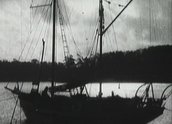


Pearls and Savages (1921)
Synopsis
A silent, black-and-white film, Pearls and Savages records two trips by adventurer, photographer and filmmaker Frank Hurley to the Torres Straits Islands and Papua New Guinea between 1921 and 1923. The first trip was under the auspices of the Anglican Board of Missions and the second as the leader of his own privately-funded expedition.
Hurley filmed Indigenous peoples as he travelled through the Torres Strait Islands, including sequences showing the pearling industry on Thursday Island, demonstrations of traditional dances and string figure designs on Murray Island, a model boat regatta on Coconut Island, food preparation on Mabuiag and fishing practices on Darnley. The Papua New Guinea footage is equally varied and vibrant.
In 1979, Keith Pardy from the National Film Archive of the National Library of Australia prepared this reconstructed version of Pearls and Savages from preservation materials. The intertitles – based on a 1925 program brochure, Hurley’s diaries, and his book Pearls and Savages: Adventures in the Air, On Land and Sea in New Guinea (New York, Putnam’s Sons, 1924) – use quotation marks to indicate Hurley’s own words. Andrew Pike, then at the Research School of Pacific Studies, ANU, researched the film, and Andrew McGuiness performed the soundtrack, based on Papuan themes and composed by Emmanuel Aarons for the film’s original presentation by Hurley.
Curator’s notes
The screening of Pearls and Savages in the 1920s created a real spectacle. This travelogue, or multi-media entertainment package, included a lecture by Hurley, orchestral mood music, Papuan music recordings, a presentation of hand-coloured lantern slides and associated publications. A version of the film with intertitles substituted for the lecture if Hurley wasn’t available.
This film may appear ethnographic but Frank Hurley was primarily a photographer. His interest lay in the commercial image rather than the production of an ethnographic record: he used the camera to create art rather than to document actuality.
In fact, Hurley helped establish the adventure film genre, with a format replicated by many adventure travel programs today. He went to great lengths to get exciting footage. For example, to produce the underwater imagery, Hurley modified a pearl-diver’s suit; he filmed from his boat to produce an endless pan along riverfront villages; and used an aircraft to shoot aerial footage.
One intertitle refers to ‘citadels of headhunters’ then shows Hurley’s party walking across grassland carrying rifles, as spears fly between them and the camera. It would seem this obviously staged scene aimed to create drama for this ’headhunter’ sequence.
Blurring the line between fiction and non-fiction became a hallmark of Hurley’s work, triggering ongoing debate about its authenticity. He never let the truth get in the way of his story. In the intertitles he describes the ‘tribe of headhunters’ as bearing ‘a striking resemblance to the ancient Jews of Babylon’. Pitching the film to an American audience Hurley changed the title to The Lost Tribe and printed a poster to accompany the screening with a by-line stating ‘Thrilling Adventures and Discovery of the Semitic “Sambo” Savages’.
This adventure journey travels to the coastal villages of Urama and Kaimare at the mouth of the Kikori River, in the Gulf of Papua. Allan McCulloch, a biologist from the Australian Museum in Sydney, accompanied Hurley on the second trip to Papua. Senior Indigenous men from Kaimare took Hurley and McCulloch into a very large traditional longhouse, a building where they conduct important cultural business and store highly significant cultural artefacts and materials.
Hurley and McCulloch dubiously obtained hundreds of cultural objects including sacred materials from Indigenous peoples during this trip. The administrator of the Territory at the time, Sir Hubert Murray, intervened in the matter and some sacred objects were returned to their Indigenous owners. Hurley and McCulloch deposited the remaining 800 items in the Australian Museum, in Sydney. Two years after this incident, the Territory’s administrator refused to allow Hurley back into Papua to make any more films.
The National Film and Sound Archive holds a large number of still images associated with the film, including a full-length photograph of Frank Hurley holding up a poster with one of the film’s alternate titles – Headhunters of Unknown Papua – which is the title of the second edition of Pearls and Savages, and a 12-page publicity booklet for the film from 1921.
A beautiful film on face value, but dig a little deeper and the stories behind this film seem as big and enduring as the film itself. The issues surrounding its making, namely the representation, cultural appropriation, and repatriation of cultural materials, remain as pertinent today as when Hurley produced this footage in the 1920s.
A major commercial success in Australia, North America and Britain, Pearls and Savages was released in Australia at the Globe Theatre on George Street, Sydney, in December 1921. It screened three times a day for five months before touring nationally. It was released in America under the title The Lost Tribe in 1923. The film was released in Britain at the Royal Opera House, Covent Garden, and went on to a record-breaking season at the Polytechnic Theatre before touring nationally.
- Overview
- Curator’s notes
- Video 3 clips
- Principal credits
- Find a copy
- Make a comment
- Map
- Add your review



